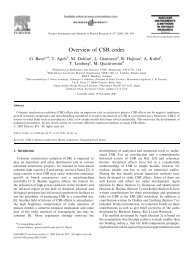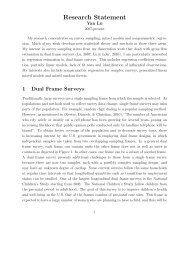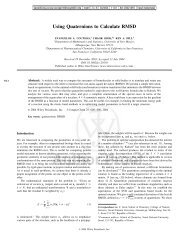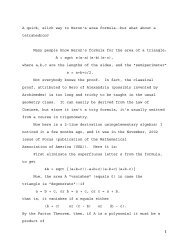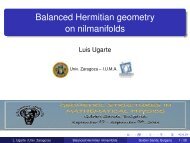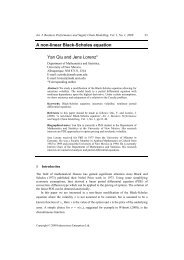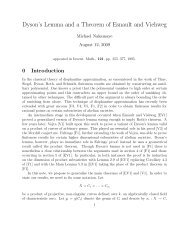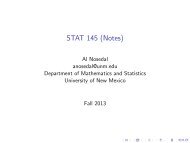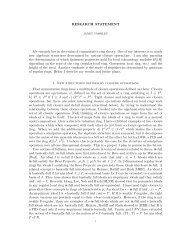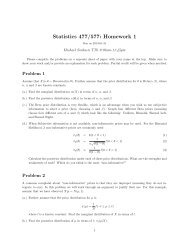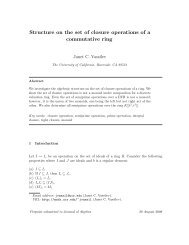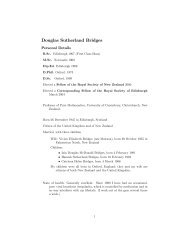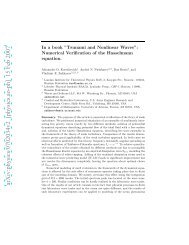OEO Office of Equal Opportunity - Department of Mathematics and ...
OEO Office of Equal Opportunity - Department of Mathematics and ...
OEO Office of Equal Opportunity - Department of Mathematics and ...
You also want an ePaper? Increase the reach of your titles
YUMPU automatically turns print PDFs into web optimized ePapers that Google loves.
144 ARTS AND SCIENCES<br />
languages <strong>and</strong>/or other skills as determined by the student’s<br />
Committee on Studies; 2) pass a Ph.D. comprehensive<br />
examination; <strong>and</strong> 3) present the major topic <strong>of</strong> the proposed<br />
dissertation <strong>and</strong> explain the intended content.<br />
Anthropology (ANTH)<br />
Introductory Courses<br />
for Undergraduates<br />
101. Introduction to Anthropology. (3)<br />
Surveys the breadth <strong>of</strong> anthropology, introducing students to<br />
archaeology, biological anthropology, ethnology, human evolutionary<br />
ecology <strong>and</strong> linguistics. Meets New Mexico Lower<br />
Division General Education Common Core Curriculum Area<br />
IV: Social/Behavioral Sciences (NMCCN 1113).<br />
110. Language, Culture <strong>and</strong> the Human Animal. (3)<br />
Dinwoodie, Gorbet<br />
(Also <strong>of</strong>fered as LING 101.) Fundamentals <strong>of</strong> anthropological<br />
linguistics. The biological, structural, psychological <strong>and</strong> social<br />
nature <strong>of</strong> language; implications for cross-cultural theory,<br />
research <strong>and</strong> applications.<br />
121L. Archaeological Method <strong>and</strong> Theory. (4)<br />
Introduction to archaeological method <strong>and</strong> theory. Lectures<br />
cover basic concepts <strong>and</strong> strategy. Labs provide h<strong>and</strong>son<br />
experience with methods <strong>of</strong> analyzing archaeological<br />
remains.<br />
130. Cultures <strong>of</strong> the World. (3)<br />
Basic concepts <strong>and</strong> methods <strong>of</strong> cultural anthropology.<br />
Selected cultures, ranging from preliterate societies to<br />
aspects <strong>of</strong> urban civilization. Meets New Mexico Lower<br />
Division General Education Common Core Curriculum Area<br />
IV: Social/Behavioral Sciences (NMCCN 2113).<br />
150. Evolution <strong>and</strong> Human Emergence. (3)<br />
Fundamentals <strong>of</strong> biological anthropology <strong>and</strong> principles <strong>of</strong><br />
organic evolution, in relation to the biology, ecology <strong>and</strong><br />
behavior <strong>of</strong> primates <strong>and</strong> fossil humans. Biological anthropology<br />
concentrators are required, <strong>and</strong> others are encouraged,<br />
to enroll concurrently in 151L. Meets New Mexico Lower<br />
Division General Education Common Core Curriculum Area<br />
IV: Social/Behavioral Sciences.<br />
151L. Human Evolution Laboratory. (1)<br />
The factual basis <strong>of</strong> human evolution, from the comparative<br />
study <strong>of</strong> living <strong>and</strong> fossil primates to interpretation <strong>of</strong> recent<br />
human fossils. Recommended, but not required, that this be<br />
taken concurrently with 150. Two hrs. lab.<br />
160. Human Life Course. (3) Kaplan, Lancaster<br />
Biology <strong>and</strong> behavior <strong>of</strong> the human life course, including<br />
the evolution <strong>of</strong> the life history patterns specific to humans<br />
<strong>and</strong> the impact <strong>of</strong> population growth <strong>and</strong> <strong>of</strong> adaptation to<br />
local conditions in promoting human diversity. Students are<br />
encouraged, but not required, to enroll concurrently in 161L.<br />
161L. Computer Laboratory in Human Evolutionary<br />
Ecology. (1)<br />
Introduces the computer as a tool in biological <strong>and</strong> social<br />
science research, provides first-h<strong>and</strong> experience in data collection,<br />
analysis <strong>and</strong> modeling behavior. No prior computer<br />
experience required.<br />
Pre- or corequisite: 160.<br />
220. World Archaeology. (3)<br />
Introduces archaeological theory, method <strong>and</strong> technique by<br />
presenting the developmental history <strong>of</strong> human cultures.<br />
230. Topics in Current Anthropology. (3, no limit) ∆<br />
Experimental courses on topics <strong>of</strong> current interest.<br />
238. Cultures <strong>of</strong> the Southwest. (3)<br />
Basic concepts <strong>of</strong> cultural anthropology, illustrated with overviews<br />
<strong>of</strong> social <strong>and</strong> cultural patterns <strong>of</strong> Southwest Indians<br />
<strong>and</strong> Hispanics. Interethnic relations <strong>of</strong> these with other<br />
American populations. Meets New Mexico Lower Division<br />
General Education Common Core Curriculum Area IV: Social/<br />
Behavioral Sciences. {Offered periodically}<br />
251. Forensic Anthropology. (3) Komar, Staff<br />
This course is designed to introduce students to the forensic<br />
investigation <strong>of</strong> death. Emphasis will be on current methods<br />
<strong>and</strong> techniques <strong>and</strong> include the role <strong>of</strong> the anthropologist as<br />
an integral member <strong>of</strong> the investigation process.<br />
Upper Division Courses<br />
for Undergraduates<br />
In general, prerequisites are listed with each course description.<br />
If none are listed, the class is designed for those without<br />
previous courses in anthropology. If course does not show<br />
a time <strong>of</strong> <strong>of</strong>fering or is “<strong>of</strong>fered periodically,” please consult<br />
the department. At the end <strong>of</strong> each course description, a<br />
letter designation signifies the concentration specialization<br />
for which this class can be used. (“A” for Archaeology; “B” for<br />
Biological; “E” for Ethno-Linguistics; <strong>and</strong> “HEE” for Human<br />
Evolutionary Ecology.)<br />
304./504. Current Research in Anthropology. (1-3)<br />
This course familiarizes students with current, active research<br />
in Anthropology by the University <strong>of</strong> New Mexico faculty <strong>and</strong><br />
visiting scholars. It also teaches students to critically assess<br />
<strong>and</strong> discuss research questions. (A, B, E, HEE)<br />
310./511. Language <strong>and</strong> Culture. (3)<br />
(Also <strong>of</strong>fered as CJ 319, LING 359.) Examination <strong>of</strong> the interrelations<br />
<strong>of</strong> language <strong>and</strong> speech with other selected aspects<br />
<strong>of</strong> culture <strong>and</strong> cognition.<br />
Prerequisites: 110 or LING 101 or LING 292. (E)<br />
*312. Oral Narrative Traditions. (3)<br />
Western <strong>and</strong> non-Western myths, epics, folk tales, life-stories<br />
<strong>and</strong> personal experience narratives as cultural <strong>and</strong> aesthetic<br />
expressions. (E) {Offered periodically}<br />
317./517. Phonological Analysis. (3) Gorbet<br />
(Also <strong>of</strong>fered as LING 304.) Phonetic principles <strong>and</strong> phonological<br />
theory, descriptive analysis <strong>of</strong> phonological systems,<br />
transcriptional practice <strong>and</strong> problems from selected<br />
languages.<br />
Prerequisite: LING 303. (E) {Fall}<br />
*318. Grammatical Analysis. (3)<br />
(Also <strong>of</strong>fered as LING 322 <strong>and</strong> 522.) Principles <strong>of</strong> morphological<br />
<strong>and</strong> syntactic analysis <strong>and</strong> introduction to functional<br />
<strong>and</strong> formal theories <strong>of</strong> grammar. Descriptive analysis <strong>of</strong> grammatical<br />
structures <strong>and</strong> problems from a variety <strong>of</strong> languages.<br />
Prerequisite: LING 292 or SIGN 305. (E) {Spring}<br />
320./520. Strategy <strong>of</strong> Archaeology. (3) Boone,<br />
Ramen<strong>of</strong>sky<br />
The purpose <strong>and</strong> theory <strong>of</strong> the study <strong>of</strong> archaeology; relates<br />
archaeology to anthropological principles <strong>and</strong> the practice<br />
<strong>of</strong> science.<br />
Prerequisites: 101 <strong>and</strong> either 121L or 220. (A) {Yearly}<br />
321./521. Southwest Archaeology. (3) Wills, Crown<br />
An intensive survey <strong>of</strong> Southwest prehistory including discussion<br />
<strong>of</strong> major interpretative problems. Covers the period from<br />
11,000 years ago to historic times. (A)<br />
322./522. Mesoamerican Prehistory. (3) Santley<br />
An advanced survey <strong>of</strong> the prehistory <strong>of</strong> Mexico, Guatemala<br />
<strong>and</strong> Belize from the origins <strong>of</strong> village farming to the Spanish<br />
conquest. (A)<br />
323./523. Archaeology <strong>of</strong> Eastern North America. (3)<br />
Ramen<strong>of</strong>sky<br />
A survey <strong>of</strong> the archaeology <strong>of</strong> Eastern North America that<br />
begins with human entry into the East <strong>and</strong> terminates with<br />
European discovery <strong>and</strong> settlement. (A) {Alternate years}<br />
UNM CATALOG 2006–2007 Symbols, page 611.



